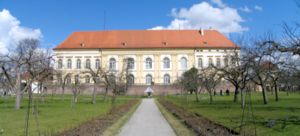- Dachau Palace
-
The Dachau Palace is a former residence of the rulers of Bavaria at Dachau, southern Germany.
History
The castle was constructed around 1100 as a castle by the cadet branch of the House of Wittelsbach. In 1182, the last Count of Dachau, Konrad III, died without issue and Duke Otto I of Bavaria took possession of it shortly thereafter. The original castle was demolished between 1398 and 1403.
William IV of Bavaria and his son Albert V ordered the construction of a Renaissance style four-wing palace with a court garden on the site of the old castle. The new building was designed by Heinrich Schöttl; construction began in 1546 and was completed in 1577. It later became the favoured residence of the rulers of Bavaria. In 1715, Maximilian II Emanuel commissioned a redesign in Baroque style by Joseph Effner.
Only the south-west wing is extant; King Maximilian I ordered the other 3 wings to be demolished in the early 19th century. They had suffered extensive damage at the hands of Napoleonic troops.
Description
The Palace is managed by the Bavarian Administration of State-owned Palaces, an administrative department of the Free State of Bavaria. It is open to visitors and the Banqueting Hall can be booked for special events. It is also used as a venue for classical concerts.
The main sight of the palace is the banqueting hall with its coffered Renaissance ceiling, designed and created between 1564 and 1566 by Hans Wisreutter, which was restored to the palace in 1977. The view from the top of the Schlossberg overlooks Munich and extends to the German Alps.
External links
- Dachau Palace site from the Bavarian Administration of State-owned Palaces
- Page on Dachau Castle on the website of the city of Dachau
Coordinates: 48°15′29″N 11°25′59″E / 48.25806°N 11.43306°E
Categories:- Royal residences in Bavaria
- Palaces in Bavaria
- Museums in Bavaria
- Baroque architecture in Bavaria
- Historic house museums in Germany
- 1710s architecture
- Bavaria building and structure stubs
Wikimedia Foundation. 2010.

